初中英语总复习知识点归纳基本全了
精编初中英语中考总复习语法知识总结归纳大全

初中英语语法大全一.词类(Parts of Speech)名词英文名称The Noun(缩写为n.) 表示人或事物的名称,例词:job 工作He's trying to get a job.他正在找工作。
table 桌子I'd like a table for two at about 8:30, please.我想订一张8:30左右的双人桌。
phone 电话I have to make a phone call.我得打个电话。
car 汽车Where can I park the car?我可以在哪里停车呀?cat 猫Your cat isn't very friendly.你的猫不太友好。
冠词英文名称The Article(缩写为art.) 用在名词前帮助说明名词所指的人和或事物,例词:a(an)There's a visitor for you.有位客人找你。
theThe phone rang.电话铃响了。
代词英文名称The Pronoun(缩写为pron) 用来代替名词、形容词或是数词,例词:I 我we 我们you 你,你们he 他she 她it 它that 那this 这what 什么形容词英文名称The Adjective(缩写为adj.) 用以修饰名词,表示人或事物的特征,例词:new 新的This idea isn't new.这主意不新鲜。
fast 快的That clock's an hour fast.那个钟快了一个小时。
white 白色的He had nice square white teeth.他的牙齿洁白而整齐,十分好看。
red 红色的She was red with shame.她羞愧地红了脸。
fine 美好的There is a fine view of the countryside.这里可以看到乡村的美景。
good 好的The results were pretty good.结果相当不错。
初中英语知识点归纳大全

初中英语知识点归纳大全一、单词拼写1. 人称代词:例如I(我)、you(你)、he(他)、she(她)、it(它)、we(我们)、they(他们、她们、它们)等。
2. 数字:例如one(一)、two(二)、three(三)等。
3. 形容词:例如big(大)、small(小)、happy(快乐)等。
4. 动词:例如run(跑)、write(写)、sing(唱)等。
5. 名词:例如book(书)、school(学校)、apple(苹果)等。
6. 介词:例如in(在)、on(在……上)、under(在……下面)等。
7. 副词:例如very(非常)、well(好),often(经常)等。
8. 冠词:例如a(一个)、an(一个,用于元音音素开头的词前)和the(定冠词)等。
9. 疑问词:例如who(谁)、what(什么)、where(哪里)等。
10. 情态动词:例如can(能够)、may(可能)、should(应该)等。
二、基本句型1. 主语+谓语:例如She sings.(她唱歌)2. 主语+动词+宾语:例如I like apples.(我喜欢苹果)3. 主语+动词+间接宾语+直接宾语:例如He gave me a book.(他给了我一本书)4. 主语+be动词+形容词:例如He is tall.(他很高)5. There be句型:例如There is a cat in the room.(房间里有一只猫)三、基本时态1. 一般现在时:例如I play tennis every Sunday.(我每个星期天打网球)2. 现在进行时:例如They are watching TV now.(他们正在看电视)3. 一般过去时:例如I went to the park yesterday.(我昨天去了公园)4. 过去进行时:例如She was reading a book at that time.(那时她正在读书)5. 将来时:例如She will go to Beijing next month.(下个月她将去北京)四、语法知识1. 名词单复数:例如book(单数)- books(复数)2. 形容词比较级和最高级:例如big(原级)- bigger(比较级)- biggest(最高级)3. 介词的用法:例如in(在)、on(在……上面)、at(在……处)等。
(超详)初中英语知识点归纳汇总-推荐

初中英语知识归纳总结(打印版)第一课时名词一、概述1、名词的属性:表示人或事物的名称抽象概念的词叫名词。
2、名词分普通名词和专有名词。
普通名词是表示某一类人或事物,或某种物体或抽象概念的名称。
如:teacher, desks, plates, milk, box等,专有名词表示某一特定的人、事物、地方团体、党派、国家机关、语言、节日等专用的名称。
(运用)如:China, Chinese, Saturday, June, Green, Beijing, Olympic 等。
(专有名词的第一个字母要大写)二、可数名词与不可数名词1、可数名词是指表示人或事物,可以用数来计量的名词,有单复数之分。
如:glass-----glasses; book---- books2、不可数名词是指所表示的事物不能用数来计量。
如:paper, rice, water , milk, tea等。
3、有些名词在特定情况下由不可数变为可数名词。
Light travels faster than sound; (light:光线,不可数)The lights are on. (light:灯,可数)4、不可数名词的量的表示不可数名词一般无法用数来计算,前面不能用a或an或数词来表示数量,它的量往往借助于容器来表示。
如:a glass of milk ------ four glasses of milka piece of paper ------ two pieces of papera bag of rice ------ three bags of rice三、可数名词的复数形式(识记、运用)1、可数名词在应用时有单复数之分,单数变复数有规则变化和不规则变化两种。
规则变化2、少数名词有不规则的变化形式policeman---policemen; man---men; woman---women;tooth---teeth; foot---feet; sheep---sheep; deer---deer;Japanese--- Japanese; Chinese --- Chinese; fish --- fish四、名词所有格(运用)名词的所有格是表示所有关系的形式,它也有构成上的变化。
【中考复习资料】初中英语复习知识点汇总
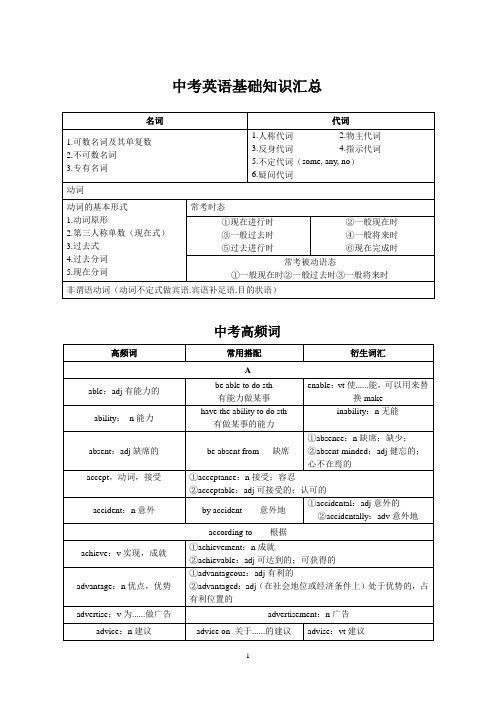
②Knock sb∕sth into a cocked hat
远远胜过某人(或事物);大大超过;是相形见绌
L
lead:引导;指引;领导;名词,铅
lead to导致;通向
leader:n领袖
leadership:n领导力
leave:vi离开
leave for去往,使某人或某物处于某种状态
date:vt约会;n日期
date sb,约会某人
depen:vi依靠,依赖
depend on依赖,取决于
①dependent:adj依靠的,依赖的②dependence:n依赖,依存,瘾,相关(性),依存(关系)③independent:adj独立的
describe:vt描述
①description:n描述
C
calendar:n日历
cancel:vt取消
capital:n首都,资本,大写字母;adj死刑的,大写的,极好的
comfortable:adj舒服的
be comfortable with自在的
①uncomfortable:adj不舒服的②comfort:n舒服;vt安慰
culture:n文化
cultural:adj文化的
⑤过去进行时
②一般现在时
④一般将来时
⑥现在完成时
常考被动语态
①一般现在时②一般过去时③一般将来时
非谓语动词(动词不定式做宾语.宾语补足语.目的状语)
中考高频词
高频词
常用搭配
衍生词汇
A
able:adj有能力的
be able to do sth
有能力做某事
enable:vt使......能,可以用来替换make
(完整版)初中英语总复习+笔记大全

初三英语总复习笔记七年级(上)Unit 1 复习要点短语和句子1、Good morning/ Good afternoon / evening 。
早上/下午/晚上好2、(It’s) Nice to meet/see you。
= (It’s)Good to meet/see you.= (I'm) Glad to meet/see you= (I’m) Pleased to meet/see you= (I'm) Happy to meet/see you. 很高兴见到你3、Welcome to China 欢迎到中国来.4、Thanks /Thank you . 谢谢5、You’re welcome 。
/ That’s all right (OK) .不用谢,6、Stand up . 起立 Sit down .坐下7、This is…。
.介绍第三者的用语,复数用These are…8、How do you do ? 您好 9、 How are you ? 您好吗? How is she\he? 她\他好吗?10、I’m fine 。
我很好。
11、What’s your/his /her name ?= May I know/have your/his /her name?Could you please tell me your/his /her name?你/他/她叫什么名字?12、My name is Jane 。
我名叫简13、Where are you from ? = Where do you come from? Where is he/she from?= Where does he/she come from?你/他/她/他们来自哪里?14、I am / He (She) is /They are from Canada/Japan/the U.S。
A/England/Cuba/China。
在初中英语知识点总结大全

在初中英语知识点总结大全一、词汇与语法1. 词汇积累- 基础词汇:掌握日常生活、学习、工作中常用的英语单词。
- 词性变化:了解名词、动词、形容词、副词等词性的构成和变化规则。
- 短语搭配:学习固定搭配和习惯用语,如动词短语、介词短语等。
2. 语法结构- 时态:掌握一般现在时、一般过去时、一般将来时等基本时态的构成和用法。
- 语态:了解主动语态和被动语态的区别及转换方法。
- 句型:熟悉陈述句、疑问句、祈使句和感叹句的结构和用法。
- 从句:学习名词性从句、定语从句和状语从句的基本构成和功能。
二、听力与口语1. 听力技巧- 听力材料:定期听取不同口音、语速和题材的英语听力材料。
- 听力策略:学会通过上下文、关键词和重复信息来预测和推断内容。
- 听力练习:通过听写、回答问题和概括大意等方式提高听力理解能力。
2. 口语表达- 发音练习:注重音标学习,模仿标准发音,纠正发音错误。
- 情景对话:通过模拟日常情景,练习实用口语对话和交流技巧。
- 表达能力:培养用英语表达思想、情感和观点的能力。
三、阅读与写作1. 阅读理解- 阅读技巧:学习扫读、略读和精读等阅读策略,提高阅读效率。
- 文章类型:了解不同类型文章的结构和特点,如记叙文、说明文和议论文。
- 阅读练习:通过回答问题、做笔记和总结来加深对文章内容的理解。
2. 写作技巧- 文章结构:掌握英语写作的基本结构,包括引言、正文和结尾。
- 写作风格:学习使用恰当的语言和句式,使文章通顺、连贯。
- 写作练习:通过写日记、书信和作文等形式,提高写作能力和创造力。
四、语言运用1. 语境理解- 语言功能:了解英语中不同的语言功能,如请求、建议、邀请等。
- 交际用语:学习在不同场合下使用的礼貌和得体的交际用语。
- 文化差异:理解不同文化背景下的语言习惯和交际方式。
2. 学习策略- 学习方法:探索适合自己的英语学习方法,如利用软件、参加英语角等。
- 时间管理:合理安排学习时间,确保每个知识点都得到充分复习和练习。
(最全)初中英语知识点归纳汇总

初中英语知识归纳总结(打印版)第一课时名词一、概述1、名词的属性:表示人或事物的名称抽象概念的词叫名词。
2、名词分普通名词和专有名词。
普通名词是表示某一类人或事物,或某种物体或抽象概念的名称。
如:teacher, desks, plates, milk, box等,专有名词表示某一特定的人、事物、地方团体、党派、国家机关、语言、节日等专用的名称。
(运用)如:China, Chinese, Saturday, June, Green, Beijing, Olympic等。
(专有名词的第一个字母要大写)二、可数名词与不可数名词1、可数名词是指表示人或事物,可以用数来计量的名词,有单复数之分。
如:glass-----glasses; book---- books2、不可数名词是指所表示的事物不能用数来计量。
如:paper, rice, water , milk, tea等。
3、有些名词在特定情况下由不可数变为可数名词。
Light travels faster than sound; (light:光线,不可数)The lights are on. (light:灯,可数)4、不可数名词的量的表示不可数名词一般无法用数来计算,前面不能用a或an或数词来表示数量,它的量往往借助于容器来表示。
如:a glass of milk ------ four glasses of milka piece of paper ------two pieces of papera bag of rice ------three bags of rice三、可数名词的复数形式(识记、运用)1、可数名词在应用时有单复数之分,单数变复数有规则变化和不规则变化两种。
规则变化policeman---policemen; man---men; woman---women;tooth---teeth; foot---feet; sheep---sheep; deer---deer;Japanese--- Japanese; Chinese --- Chinese; fish --- fish四、名词所有格(运用)名词的所有格是表示所有关系的形式,它也有构成上的变化。
初中英语中考知识点总结归纳完整版
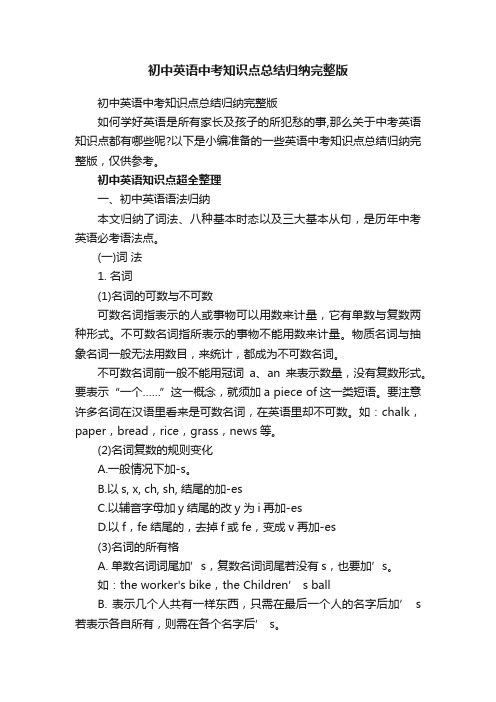
初中英语中考知识点总结归纳完整版初中英语中考知识点总结归纳完整版如何学好英语是所有家长及孩子的所犯愁的事,那么关于中考英语知识点都有哪些呢?以下是小编准备的一些英语中考知识点总结归纳完整版,仅供参考。
初中英语知识点超全整理一、初中英语语法归纳本文归纳了词法、八种基本时态以及三大基本从句,是历年中考英语必考语法点。
(一)词法1. 名词(1)名词的可数与不可数可数名词指表示的人或事物可以用数来计量,它有单数与复数两种形式。
不可数名词指所表示的事物不能用数来计量。
物质名词与抽象名词一般无法用数目,来统计,都成为不可数名词。
不可数名词前一般不能用冠词a、an来表示数量,没有复数形式。
要表示“一个……”这一概念,就须加a piece of这一类短语。
要注意许多名词在汉语里看来是可数名词,在英语里却不可数。
如:chalk,paper,bread,rice,grass,news等。
(2)名词复数的规则变化A.一般情况下加-s。
B.以s, x, ch, sh, 结尾的加-esC.以辅音字母加y结尾的改y为i再加-esD.以f,fe结尾的,去掉f或fe,变成v再加-es(3)名词的所有格A. 单数名词词尾加’s,复数名词词尾若没有s,也要加’s。
如:the worker's bike,the Children’ s ballB. 表示几个人共有一样东西,只需在最后一个人的名字后加’ s 若表示各自所有,则需在各个名字后’ s。
如:This is Lucy and Licy’ s room.These are Kate's and jack’ s rooms.C. 如果是通过在词尾加—s构成的复数形式的名词,只加’。
如:the students’ books,the girls’ blouses(另外:名词+of+名词名词是有生命的,我们就用’s结构来表示所有关系。
如果名词所表示的事物是无生命的,我们就要用名词+of+名词的结构来表示所有关系。
初中英语知识点全总结
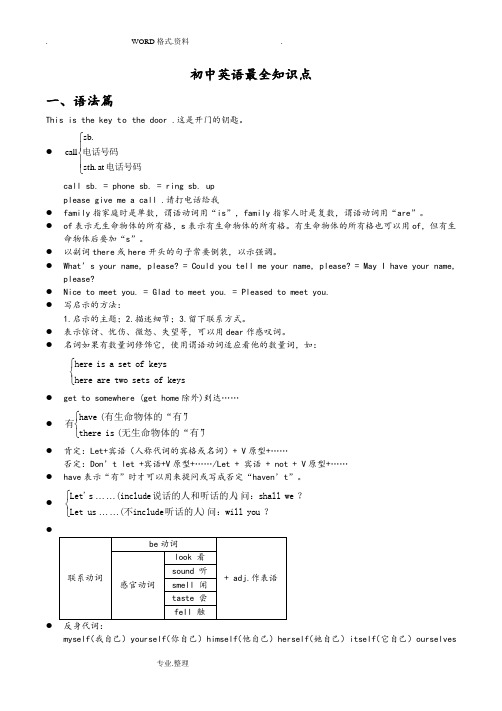
初中英语最全知识点一、语法篇This is the key to the door .这是开门的钥匙。
● ⎪⎩⎪⎨⎧电话号码电话号码at .sth .sb call call sb. = phone sb. = ring sb. upplease give me a call .请打电话给我● family 指家庭时是单数,谓语动词用“is”,family 指家人时是复数,谓语动词用“are”。
● of 表示无生命物体的所有格,s 表示有生命物体的所有格。
有生命物体的所有格也可以用of ,但有生命物体后要加“s”。
● 以副词there 或here 开头的句子常要倒装,以示强调。
● What’s your name, please? = Could you tell me your name, please? = May I have your name, please?● Nice to meet you. = Glad to meet you. = Pleased to meet you.● 写启示的方法:1.启示的主题;2.描述细节;3.留下联系方式。
● 表示惊讶、忧伤、微怒、失望等,可以用dear 作感叹词。
● 名词如果有数量词修饰它,使用谓语动词适应看他的数量词,如:⎩⎨⎧ keys of sets two are here keysof set a is here● get to somewhere (get home 除外)到达……● ⎩⎨⎧)无生命物体的“有”( is there )有生命物体的“有”( have 有 ● 肯定:Let+宾语(人称代词的宾格或名词)+ V 原型+……否定:Don’t let +宾语+V 原型+……/Let + 宾语 + not + V 原型+……● have 表示“有”时才可以用来提问或写成否定“haven’t”。
● ⎩⎨⎧⋯⋯⋯⋯? you will 问: )听话的人include 不(us Let ? we shall 问: )说话的人和听话的人(include s Let' ●● myself (我自己) yourself (你自己) himself (他自己) herself (她自己) itself (它自己) ourselves(我们自己) yourselves(你们自己) themselves(他们自己)●How much + be + 商品?(答:It’s/They’re……)= What is the price of……?(答:It ’s……)●cent 美分 One dollar =100 cents●other(两者中的另一个) another(三者中的另一个)●越接近物品本身性质的形容词越靠近物品,如:big blue hat●帮助某人做某事help sb. (to) do sth.help sb. with sth.with the help (n.) of sb. e.g. He studies math well, with the help of teacher.●一般将来时的一般形式:主语+will+动词原形+……●Can I help you? = What can I do for you? = (Is there) anything I can do for you?●●●“hundred,thousand”与基数词一起表示具体数字时不加“s”。
初中英语总复习大全

初中英语总复习大全The document was prepared on January 2, 2021初中英语中考总复习大全目录第一篇词法一、名词(一) 知识概要名词的概念在不同的语法教课书中有不同的解释和分类方法,但就实际应用来讲还是不要过分地追求其理论概念,而更多的要把注意力放在其应用上来。
我们不妨把它分为两大类:专有名词与普通名词。
顾名思义,专有名词是指:个人、事物、机关等所专有的名称,如,the Great Wall, America…它们是不能随意变动的。
而普通名词中则包括个体名词,如pen, worker…它表示单一的个体人或事物;集体名词,如:family,class, team,它表示的是由若干个个体组成的集合体;物质名词,如:water,paper…它表示的是一种物质,原材料;而后一种是抽象名词,如:work, time…它表示着一种在实际生活中看不见、摸不到,但却与实际生活紧密相关的某些动作、状态、品质的抽象概念。
见下表。
名词一览表种类专有名词London, John, the Communist Party of China普通名词类名词 nurse, boy, worker, pencil, dog, table集体名词 class, family, army, police, team, people物质名词 water, steel, glass, cotton, wood, sand抽象名词 happiness, love, work, life, courage, honest功用主语 My family is now in New York.表语 His father is a scientist.宾语 We love our great motherland.宾语补足语 He made London the base for his work.定语 The girls are making paper flowesrs.状语 The car cost him 1000 dollars.同位语 Mr Brown, a famous scientist, will come here.名词在使用中的难点在于名词的数,即可数名词与不可数名词的实际应用。
初中英语知识点超全整理,初一到初三(含语法重难点100单选及答案)

初中英语知识点超全整理,初一到初三(含语法重难点100单选及答案)初中英语知识点超全整理,初一到初三一、初中英语语法归纳本文归纳了词法、八种基本时态以及三大基本从句,是历年中考英语必考语法点。
(一)词法1. 名词(1)名词的可数与不可数可数名词指表示的人或事物可以用数来计量,它有单数与复数两种形式。
不可数名词指所表示的事物不能用数来计量。
物质名词与抽象名词一般无法用数目,来统计,都成为不可数名词。
不可数名词前一般不能用冠词a、an来表示数量,没有复数形式。
要表示“一个……”这一概念,就须加a piece of这一类短语。
要注意许多名词在汉语里看来是可数名词,在英语里却不可数。
如:chalk,paper,bread,rice,grass,news等。
(2)名词复数的规则变化A.一般情况下加-s。
B.以s, x, ch, sh, 结尾的加-esC.以辅音字母加y结尾的改y为i再加-esD.以f,fe结尾的,去掉f或fe,变成v再加-es(3)名词的所有格A. 单数名词词尾加’s,复数名词词尾若没有s,也要加’s。
如:the worker's bike,the Children’s ballB. 表示几个人共有一样东西,只需在最后一个人的名字后加’s若表示各自所有,则需在各个名字后’s。
如: This is Lucy and Licy’s room.These are Kate's and jack’s rooms.C. 如果是通过在词尾加—s构成的复数形式的名词,只加’。
如:the students’books,the girls’blouses(另外:名词+of+名词名词是有生命的,我们就用’s结构来表示所有关系。
如果名词所表示的事物是无生命的,我们就要用名词+of+名词的结构来表示所有关系。
)2. 代词人称代词,物主代词,反身代词,指示代词,不定代词(1)人称代词第一人称单数I me my mine myself复数 we us our ours ourselves第二人称单数 you you your yours yourself复数 you you your yours yourselves第三人称单数 he him his his himselfshe her her hers herselfit it its its itself复数 they them their theirs themselves(2)物主代词物主代词的用法:形容词性物主代词后面一定要跟上一个名词;名词性物主代词可作主语、表语、宾语。
初中英语知识点归纳汇总
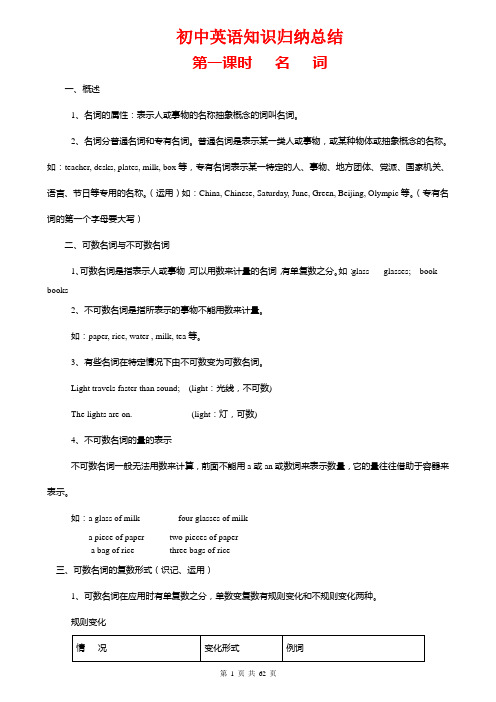
初中英语知识归纳总结第一课时名词一、概述1、名词的属性:表示人或事物的名称抽象概念的词叫名词。
2、名词分普通名词和专有名词。
普通名词是表示某一类人或事物,或某种物体或抽象概念的名称。
如:teacher, desks, plates, milk, box等,专有名词表示某一特定的人、事物、地方团体、党派、国家机关、语言、节日等专用的名称。
(运用)如:China, Chinese, Saturday, June, Green, Beijing, Olympic等。
(专有名词的第一个字母要大写)二、可数名词与不可数名词1、可数名词是指表示人或事物,可以用数来计量的名词,有单复数之分。
如:glass-----glasses; book---- books2、不可数名词是指所表示的事物不能用数来计量。
如:paper, rice, water , milk, tea等。
3、有些名词在特定情况下由不可数变为可数名词。
Light travels faster than sound; (light:光线,不可数)The lights are on. (light:灯,可数)4、不可数名词的量的表示不可数名词一般无法用数来计算,前面不能用a或an或数词来表示数量,它的量往往借助于容器来表示。
如:a glass of milk ------ four glasses of milka piece of paper ------two pieces of papera bag of rice ------three bags of rice三、可数名词的复数形式(识记、运用)1、可数名词在应用时有单复数之分,单数变复数有规则变化和不规则变化两种。
规则变化2、少数名词有不规则的变化形式policeman---policemen; man---men; woman---women;tooth---teeth; foot---feet; sheep---sheep; deer---deer;Japanese--- Japanese; Chinese --- Chinese; fish --- fish四、名词所有格(运用)名词的所有格是表示所有关系的形式,它也有构成上的变化。
初中英语总复习知识点归纳(基本全了)
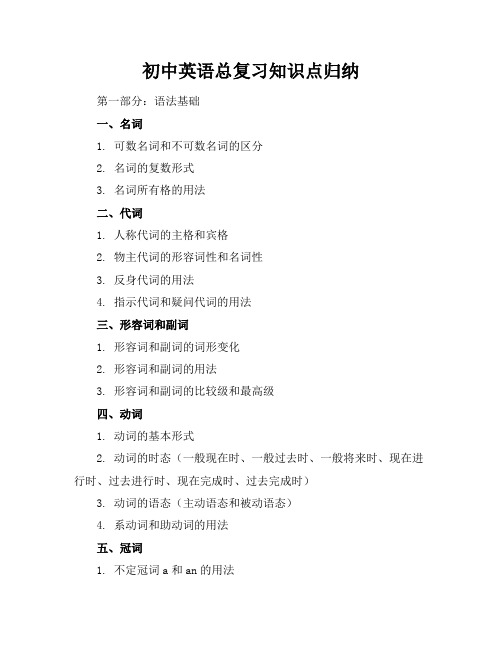
初中英语总复习知识点归纳第一部分:语法基础一、名词1. 可数名词和不可数名词的区分2. 名词的复数形式3. 名词所有格的用法二、代词1. 人称代词的主格和宾格2. 物主代词的形容词性和名词性3. 反身代词的用法4. 指示代词和疑问代词的用法三、形容词和副词1. 形容词和副词的词形变化2. 形容词和副词的用法3. 形容词和副词的比较级和最高级四、动词1. 动词的基本形式2. 动词的时态(一般现在时、一般过去时、一般将来时、现在进行时、过去进行时、现在完成时、过去完成时)3. 动词的语态(主动语态和被动语态)4. 系动词和助动词的用法五、冠词1. 不定冠词a和an的用法2. 定冠词the的用法3. 不使用冠词的情况六、连词1. 并列连词的用法2. 从属连词的用法七、介词1. 常用介词的用法2. 介词短语的结构和用法八、数词1. 基数词和序数词的用法2. 分数、小数和百分数的表达九、感叹词1. 感叹词的用法十、疑问词1. 疑问词的用法十一、句型结构1. 简单句的五种基本句型2. 并列句和复合句的结构和用法十二、主谓一致1. 主谓一致的原则2. 主谓一致的特殊情况十三、倒装句1. 完全倒装和部分倒装的区别2. 常见的倒装句型十四、省略句1. 省略句的结构和用法十五、强调句1. 强调句的结构和用法十六、虚拟语气1. 虚拟语气的用法十七、情态动词1. 情态动词的用法十八、非谓语动词1. 非谓语动词的分类和用法十九、固定搭配1. 常见的固定搭配二十、习惯用语和俚语1. 常见的习惯用语和俚语第二部分:词汇与短语一、词汇记忆方法1. 词根词缀记忆法2. 同义词和反义词记忆法3. 分类记忆法4. 联想记忆法二、常见词汇和短语1. 常用动词短语2. 常用形容词短语3. 常用介词短语4. 常用连词短语5. 常用固定搭配三、词汇辨析1. 形近词辨析2. 意思相近的词辨析3. 语境辨析四、词汇应用1. 词汇在句子中的应用2. 词汇在段落中的应用3. 词汇在文章中的应用五、词汇扩展1. 通过阅读扩展词汇2. 通过听力扩展词汇3. 通过口语和写作扩展词汇六、词汇复习策略1. 制定词汇复习计划2. 定期进行词汇测试3. 反复记忆和复习第三部分:阅读理解一、阅读技巧1. 快速阅读2. 精读3. 猜词技巧4. 理解文章主旨和大意5. 找出文章中的细节信息二、阅读题型1. 主旨大意题2. 细节理解题3. 推理判断题4. 词义猜测题5. 观点态度题三、阅读材料1. 故事类文章2. 议论文3. 说明文4. 应用文5. 新闻报道四、阅读理解策略1. 预览文章和首段2. 扫读文章找出关键词3. 仔细阅读理解文章内容4. 回答问题时注意关键词和语境5. 验证答案是否符合文章内容第四部分:写作技能一、写作技巧1. 确定写作目的和主题2. 拟定写作提纲3. 运用适当的句型和词汇4. 保持文章逻辑清晰5. 注意文章格式和标点符号二、写作题型1. 记叙文2. 议论文3. 说明文4. 应用文5. 日记和书信三、写作素材1. 人物描写2. 地点描写3. 事件描写4. 情感表达5. 观点陈述四、写作策略1. 多读优秀范文2. 多练习写作3. 请教老师和同学4. 反复修改和润色5. 保持写作兴趣和热情第五部分:听力理解一、听力技巧1. 预测听力内容2. 抓住关键词和关键信息4. 边听边记笔记5. 理解对话和独白的逻辑关系二、听力题型1. 简单听力理解题2. 听力细节理解题3. 听力推理判断题4. 听力主旨大意题5. 听力词义猜测题三、听力材料1. 对话2. 独白3. 新闻报道4. 广播节目5. 电影和电视剧片段四、听力理解策略1. 预览问题和选项2. 仔细听录音,注意关键词3. 根据听力内容进行推理和判断4. 选择最符合听力内容的答案5. 检查答案是否符合题意第六部分:口语表达一、口语技巧1. 准备话题和内容3. 保持语速适中4. 注意语法和词汇的准确性5. 保持自信和流畅二、口语题型1. 自我介绍2. 话题讨论3. 角色扮演4. 观点陈述5. 回答问题三、口语素材1. 日常生活话题2. 学校生活话题3. 社会热点话题4. 个人兴趣爱好话题5. 旅游和文化话题四、口语表达策略1. 多听多说,提高口语能力2. 模仿优秀的口语表达3. 与老师和同学进行口语练习4. 参加英语角和口语比赛5. 记录自己的口语表达,进行反思和改进第七部分:综合技能一、综合技巧1. 综合运用语法、词汇、阅读、写作、听力和口语等技能2. 注重语言的实际运用能力3. 提高语言的综合运用水平4. 培养跨文化交际能力5. 保持学习英语的兴趣和动力二、综合题型1. 完形填空2. 阅读理解3. 写作4. 听力理解5. 口语表达三、综合复习策略1. 制定综合复习计划2. 定期进行综合测试3. 反复练习和复习4. 请教老师和同学5. 保持学习英语的兴趣和热情。
最全初中英语知识点总结归纳

最全初中英语知识点总结归纳初中英语学习是一个阶段性的过程,其中需要掌握很多基础的语法、词汇和句型。
下面是初中英语的知识点总结和归纳。
1. 语法1.1 时态时态指的是动词在某一时刻时的形式,初中英语需要掌握的时态有:现在时、过去时、未来时、现在完成时、过去完成时、现在进行时、过去进行时、将来进行时和条件状语从句。
1.2 语态语态指的是动作的执行者和受事者的关系,初中英语需要掌握的语态有:主动语态和被动语态。
1.3 句型初中英语需要掌握的句型有:一般疑问句、反义疑问句、特殊疑问句、陈述句、祈使句和感叹句。
2. 词汇初中英语需要掌握的词汇量较大,其中主要包括以下几类:2.1 常用词汇常用词汇包括数字、时间、颜色、天气、身体部位、食物、衣服、动物、家庭、学校、城市、国家和人民等方面的词汇。
2.2 动词短语动词短语是初中英语中常用的一种表达方式,包括了很多常用的动词搭配,例如:get up、go to school、play basketball、watch TV等。
2.3 习惯用语习惯用语是指在日常生活中经常使用的表达方式,在初中英语中也会使用到很多习惯用语,例如:by the way、in my opinion、as a matter of fact等等。
3. 句子3.1 英语翻译英语翻译是初中英语学习中必不可少的一部分,需要掌握一定的英语表达能力,同时加强词汇量的积累。
3.2 英语作文英语作文需要掌握英语语法和词汇运用,同时还需要注意书写格式以及思路的清晰性。
3.3 英语口语英语口语需要更多地进行口头表达,让学生能够更好地练习英语口语和交流能力,掌握常用的口语表达方式。
4. 阅读4.1 短篇阅读短篇阅读需要注意对文中主旨的理解和关键词的把握,同时掌握基本的阅读技巧,例如:推断、判断和归纳等。
4.2 长篇阅读长篇阅读需要更多地进行整体理解和主旨把握,同时要注意文中细节的理解和推理能力的提高。
5. 听力初中英语听力主要包括日常会话、短对话和长对话,需要掌握一定的听力技巧,例如:辨别重点、捕捉关键词以及注意听力材料的节奏和语气。
初中英语最全知识点

初中英语最全知识点初中英语知识点主要分为以下几个方面:一、基础语法1.时态:一般现在时、一般过去时、一般将来时、现在进行时、过去进行时、将来进行时、现在完成时、过去完成时、将来完成时等。
2.动词:动词的基本用法、不规则动词的变化、情态动词的用法等。
3.名词:可数名词和不可数名词、名词的单数和复数形式、所有格等。
4.代词:人称代词、物主代词、指示代词、反身代词等。
5.形容词和副词:形容词的基本用法、形容词的比较级和最高级、副词的基本用法等。
6.介词:常用介词的用法、介词短语的用法等。
7.冠词:定冠词和不定冠词的用法。
8.疑问句和否定句:疑问代词和疑问副词的用法、否定句的构成等。
9.从句:宾语从句、主语从句、定语从句、状语从句等。
二、词汇1.基础词汇:常用动词、名词、形容词、副词、介词等。
2.重要短语:日常生活中常用的短语,如问候、道别、表达喜好、发出请求等。
3.习惯用语和固定搭配:常用的固定搭配和习惯用语,如成语、俚语等。
三、听力技巧1.听懂关键信息:根据问题的关键词,听取和理解相关信息。
2.推理判断:通过对对话或短文的整体理解和背景知识,推断出正确的答案。
3.注意细节:注意听取细节信息,如数字、时间、地点等。
四、阅读技巧1.阅读理解:理解文章的主旨、推理判断、细节理解等。
2.理解文章结构:理解文章的段落结构和逻辑关系。
3.查找信息:根据问题查找文章中的相关信息。
4.推断词义:通过上下文推断生词的意思。
五、写作技巧1.书信写作:根据指定的写信格式和要求,写一封书信。
2.作文写作:写一篇短文,描述或讨论一个话题。
六、口语交际1.日常交际用语:问候、道别、求助、表示喜好等。
2.情景对话:根据给定的情景,进行实际对话。
七、常用短语和习惯用语1.日常生活中常用的短语和习惯用语,如问路、购物、旅行等。
八、文化知识1.英语国家的风俗习惯、节日等。
以上是初中英语知识点的一个大致分类和总结,具体的知识点可能更加详细和具体。
最全初中英语知识点总结归纳

最全初中英语知识点总结归纳初中英语知识点总结1介词一些容易混淆的介词1.表示时间的at、on、in的用法区别 at主要表示:(1)在某具体时刻之前,如at seven o’ clock,at 7:30。
(2)在固定短语中,如:at noon,at night,at that time,at the age of at the weekend,at Christmas。
On用来表示“在??天”,如:On Monday,On May lst,On Children’s Day。
in用来表示:(1)在某年、某月、某季节。
(2)在—段时间之后,如:in two hours,in a few days。
注意:在纯粹地表示在上午/下午/晚上时,用in themorning/afternoon/evening,但在某一天的上午、下午、晚上前要用介词on。
如:on Monday morning,on the morning of Children’ s Day。
2. 表示地点的at,in,on的用法区别 (1) at通常指小地方,in一般指大地方。
(2) at 所指范围不太明确,in指“在??里”。
(3) in指在内部,on指“在??之上”。
3.表示“一段时间”的for与since的用法区别 for后面接时间段,since之后接时间点。
4.表示时间的before与by的用法区别 before与by都可表示“在??之前”,但by含有“不迟于??”、“到??为止”的意思。
如果by后是将来的时间,则与将来时连用,若by后是过去的时间,则与过去完成时连用。
5.over与above(under与below) over,above都表示“在??的上面”,over 表示“正上方”,而above只表示“在上方”但不一定在“正上方”。
above 还可表示温度、水位等“高于”,over还可表示“越过??”。
over的反义词是under,above的反义词是below.例如: There is a bridge over the river Our plane flew above the clouds.初中英语知识重点2形容词即是表示人或物的特征、性质或状态,修饰名词或不定代词的词。
初中英语详细知识点总结归纳大全(完整版)

初中英语详细知识点总结归纳大全(完整版)初中英语详细知识点总结归纳句子成分及基本句型首先,英语词类又叫词性,英语单词根据其在句子中的功用,可以分成十个大类:名词、动词、代词、形容词、副词、数词、冠词、介词、连词、感叹词。
前六类叫实词,后四类叫虚词。
名词可作主语、宾语,有时也可作定语。
动词可用作谓语。
一、句子的成分句子是由词按照一定的语法结构组成的能够表达完整概念的语言单位。
组成句子的部分称为句子成分。
在英文中句子成分包括:主语(Subject)、谓语(Predicate)、表语(Predicative)、宾语(Object)(直接宾语、间接宾语)、定语(attribute)、状语(adverbial) 和补语(plement)。
主、谓语是句子主体部分(在英语中,一般的句子都要有主语和谓语)。
表语、宾语和宾语补足语是谓语里的组成部分。
像定语和状语是句子的次要成分,接下来我们分别讲一讲句子的各个成分:主语主语是谓语讲述的对象,也就是表达“是什么”或“是谁”。
一般来说,是由名词、代词、不定式或相当于名词的词或短语来充当。
它在句首。
Lucy is a beautiful nurse. (名词作主语)He reads newspapers every day. (代词作主语)Smoking is harmful to the health. (动名词作主语)To swim in Kunming Lake is a great pleasure.(不定式作主语)What we should do is not yet decided. (主语从句作主语)2、谓语说明主语“是什么”“做什么”或者“怎么样”。
谓语(谓语部分里主要的词)必须用动词。
谓语和主语在人称和数两方面必须一致。
它在主语后面。
His Parents are doctors. (系动词和表语一起作谓语)She looks well.(系动词和表语一起作谓语)We study hard.(实义动词作谓语)We have finished reading the book. (助动词和实义动词一起作谓语)He can speak English. (情态动词和实义动词作谓语)3、表语表语说明主语“是什么”或者“怎么样”,由名词、副词、介词、形容词、不定式及相当于名词或形容词的词或短语来充当。
初中中考所有的英语知识点(汇总大全)

初中中考所有的英语知识点(汇总大全)初中中考所有的英语知识点代词人称代词,物主代词,反身代词类别主格宾格形容词性物主代词名词性物主代词反身代词第一人称单数I me my mine myself复数 we us our ours ourselves第二人称单数 you you your yours yourself复数 you you your yours yourselves第三人称单数 he him his his himselfshe her her hers herselfit itits its itself复数 they them their theirs themselves1.人称代词人称代词it的特殊用法:一般it指“它”,但在表示天气、时间、距离等时,用it来代替,此时的it并不译为“它”。
当三个人称代词(单数)同时出现时,其先后顺序为you,he,I。
而复数一般采用we,you,they顺序。
2.物主代词物主代词的用法:形容词性物主代词后面一定要跟上一个名词。
名词性物主代词可作主语、表语、宾语。
3.反身代词1)反身代词的构成分两种:第一、二人称反身代词在形容词:性物主代词后加上self或selves,第三人称的反身代词在宾格代词后加上self或selves.2)反身代词的用法:一种是作宾语,由主语发出的动作又回到动作者本身。
如:I enjoyed myself at the party.另一种是作名词或代词的同位语;用来加强语气。
如:I can do it myself.初中中考所有的英语知识点梳理主要不定代词的用法:(1)one的用法A. one作为代词可以指人,也可以指物。
B. one,ones (one的复数形式) 可用来代替前面出现过的少数名词,以避免重复。
C. one的前面可用this,that,the,which等词来修饰。
D. 常有a+形容词+one这一形式。
it和one的用法区别:it用来指特定的东西,而one则用于替代不特定的东西。
- 1、下载文档前请自行甄别文档内容的完整性,平台不提供额外的编辑、内容补充、找答案等附加服务。
- 2、"仅部分预览"的文档,不可在线预览部分如存在完整性等问题,可反馈申请退款(可完整预览的文档不适用该条件!)。
- 3、如文档侵犯您的权益,请联系客服反馈,我们会尽快为您处理(人工客服工作时间:9:00-18:30)。
' 共有 ' 。 John's and Mary's room (两间)
John and Mary's room (一间)
6 ) 复合名词或短语, 's 加在最后一个词的词尾。 如:a month or two's absence
7)双重所有格
a friend of mine / hers / his / theirs
---Oh, who was it?
⑤用作形式主语。
It ’s kind / good / n
ice /clever /polite / foolish of sb. to do sth.
It ’s important / necessary / possible / easy / difficult for sb to do sth, It ’s time to get up.
one 同类而不同一。
that 常用于比较结构中,代替前面提到的名词,以避免重复。
have a good time
have a try
in a
hurry
after a while
keep a diary
go for a walk
in a
minute
in a word
in a short while
an 则用于元音音素前 an hour, an honest boy , an keep an eye on
the end, all the time
at the same time
on the whole, by the way, go to
the cinema at he age of six at the beginning of the twenty-first century
on
the other side of
3)指世上独一物二的事物 the sun ( sky / moon/
earth/ world/ nature/
universe )
4)单数名词连用表示一类事物,如: the dollar 美元 ; The lion is a wild animal.
或与形容词或分词连用,表示一类人: the rich /poor/ blind/ aged / living / impossible
wolf---wolves wife---wives
life---lives
thief---thieves
(加 s,如: belief---beliefs
roof---roofs safe---safes
gulf---gulfs ;)⑤以辅音字母 +y 结尾的词, 变 y 为 i ,再加 es baby---babies
are-
④
A cup\ glass \bottle
\box \ kilo
\ group \
crowd \ class \
pair of
Two and a half kilos of = two kilos and a half of
名词所有格 在英语中有些名词可以加 "'s" 来表示所有关系, 带这种词尾的名词形式
in
the north of China
8)用在普通名词构成专有名词前: the People's Republic of China
the United
States the Great Wall
the Summer Palace
9) 用在姓氏的复数名词之前,表示一家人: the Greens are playing the piano. 10) in the day, in the morning (afternoon , evening), in the middle (of), in
a friend of Mary’s
mother ’ s
代词
1、人称代词、物主代词和反身代词
I — meቤተ መጻሕፍቲ ባይዱ my— mine — myself
you —you — your — yourself (yourselves)
he— him — his — his — himself she —her — her — hers — herself
German---Germans
women doctors
集体名词 : People, police,( 一般表示一个整体,谓用复数 ) class, family, glasses
不可数名词:
常见的不可数名词有: information, news, room
(空间), work, work, weather,
初中英语总复习知识点归纳
冠词 a / an 的用法
a 用于辅音音素前
a useful book,
a university,
a “u”
Once a week
have a swim/walk/talk/look/dance/drink/ rest
have a
cold/ headache / fever /cough
⑥
不规则:a. 单复数形式一样。 Sheep, deer, Chinese, Japanese. People, police, scissors,
trousers b. 其他的。 foot — feet tooth---teeth
child — children mouse---mice
man---men woman---women businessman ---businessmen
5)用在序数词和形容词最高级,及形容词
only , very, same 等前面: I live on the
second floor. 6)用在表示身体部位的名词前:
She caught me by the arm.
7)用在表示乐器和表方位的名词之前:
She plays the piano \violin \ guitar
it — it — its — its —itself
we —us— our —ours — ourselves
they — them— their — theirs — themselves
人称顺序 you, he, she, I ;
we, you, they
主格作主语;宾格作宾语,动词和介词之后通常作宾格;形容词性物主代词不能单独
at the moment
the day after tomorrow
the day before
yesterday, the next morning, in the sky (water , field ,country) in the dark, in
the rain,
不用定冠词的情况
1) 国名,人名前通常不用定冠词: China , Europe
in hospital 生病住院 in the hospital
在医院里
in front of
在 --- 的前面 in the front of
在 ---- 内部的前面
go to school 上学 go to the school
到学校去
a number of = a lot of
许多,谓语动词用复数。
advice, bread , food, milk, tea, ice, glasses, meat
①
A little, a bit of, some, much, a lot of, quite a lot of
常修饰不
可数名词 .
②
不可数名词作主语,谓语动词用单数。
③
如果用 and 连接两个不可数名词作主语时, 谓语动词用复数。 Time and money
“A E F H I L M N O R S X ”
定冠词 the 的用法:
1)特指双方都明白的人或物: Give me the book.
2)上文提到过的人或事: ---Do you know the lady in blue? – Yes, she is a teacher
of a university.
It ’s time for lunch.
It ’s one ’s turn to do
It seems that
It takes sb. some time to do sth.
⑥用作形式宾语。 Find / think / feel + it +adj +to do sth
It one 的区别
It 特指上文提到的同一对象,同一事物。
The number of ---- 的数目, ---- 的总数, 谓语动词用单数(第三人称单数)
名词:专有名词和普通名词(个体名词、集体名词、物质名词、抽象名词)
可数名词的单数变复数①一般情况加 s ②以 s, x sh ch, 等结尾的词加 -es
bus-buses watch-watches
③以 o 结尾的名词,无生命的加 s,如: photo---photos
autumn/ winter
6)当 by 与火车等交通工具连用, 表示一种方式时, 中间无冠词; by bus/ train/ taxi/
bus/ ship
7) Day and night face to face side by side step by step
watch TV at
school / work / home
piano---pianos 有生命的 es,如: potato--potatoes
tomato--tomatoes
